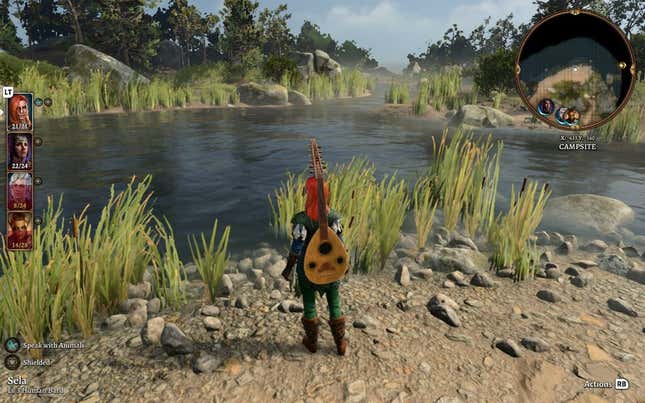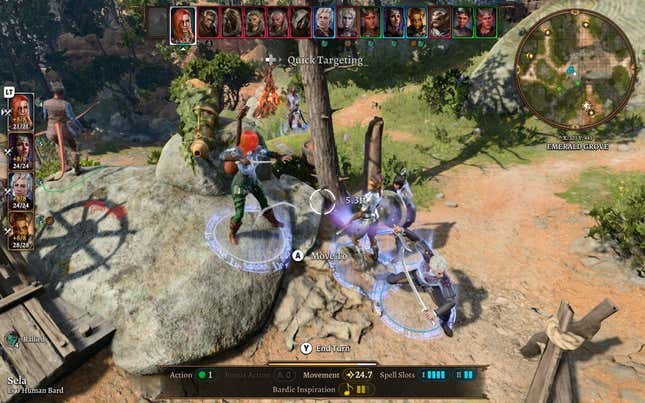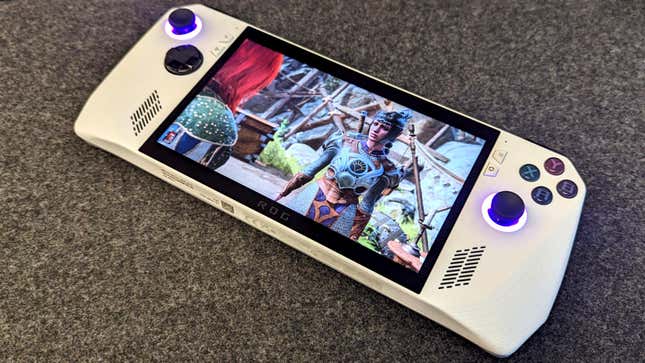
The big, enormous, mega-large final version of Larian’s addition to the Baldur’s Gate franchise is out and it’s getting a ton of attention for its depth, multifaceted outcomes, and generally solid adaptation of the Dungeon & Dragons ruleset. It’s also a very visually pretty game, with wonderfully detailed environments and character models.
So with a game this enormous and visually rich, does it run well on Valve’s Steam Deck? Let’s cut to the chase: Yes, absolutely. Baldur’s Gate 3 is a solid experience on Steam Deck. In fact, my play time has been divided pretty evenly between desktop and Steam Deck, both on the couch and on the go.
But there are a few things you should know before firing up Faerûn on your Deck. Default settings aren’t ideal if I’m being honest, and you should set your expectations appropriately. So let’s dive into how to adjust your graphics settings, along with a few observations based on my time with it on Deck as well as on the ROG Ally.
Baldur’s Gate 3 on Steam Deck: Expect a serviceable ~30-FPS experience
If you’re planning to play BG3 on Steam Deck, expect a mostly stable 30-FPS experience. And when I say mostly stable, what I mean is expect some dips down into the 20s and maybe a touch lower here and there.

The dips are there, but I don’t think that, in this game’s case at least, they’re a deal-breaker. Consider the kind of game Baldur’s Gate 3 is: A mostly narrative game with exploration and turn-based combat. It’s a game that looks nicer at high framerates, but it’s hardly a requirement like it would be for a faster, more reaction-based game. This is a perfectly fine 30-frames-per-second game and the dips that do exist, while not ideal, hardly make this game unplayable.
I have read some accounts of folks getting 40 frames per second with decent results. And, sure, the Deck can run this game at such framerates, but in my opinion overall stability is a little rockier, resulting in more frequent dips that I personally have found distracting.
Finally, Baldur’s Gate 3 is a physically large game, about 120 GB large. If you’re downloading on Wi-Fi (or even hardwired via a dock) be ready to wait a bit. Download the game well-beforehand if you intend to play it on an upcoming trip.
Baldur’s Gate 3 Steam Deck Graphics Settings (Shut FSR off, for the love of the gods)
You’ve got a bit of versatility when it comes to Steam Deck graphics settings for Baldur’s Gate 3, but no matter what, you should absolutely shut FSR completely off.

FSR is AMD’s spatial upscaling tech, and while version 2 is definitely an improvement, FSR 1.0 is just gross-looking. Sadly, Baldur’s Gate 3, at the time of writing, only has FSR 1.0. Should the game receive an update that includes FSR 2.0, it might be worth messing with, but for now, avoid FSR like a damn Illithid tadpole. It results in a melty, god awful image that looks like you smeared vaseline underneath the glass of your screen. The minor framerate improvement you get from this feature is not worth how yucky this looks.

For all of the other settings, you generally don’t want to go above Medium, and Low is a good option for a few critical settings like shadows. Here are my settings on the Deck that you can adjust to taste, potentially getting slightly lower or higher framerates. I’ve omitted non-adjustable settings like Display Adapter from this list.
Aspect Ratio: 16:10
Resolution: 1280 x800
Display Mode: Fullscreen
VSync: Off
Frame Rate Cap: On
Maximum Frame Rate: 30
Model Quality: Medium
Detail Distance: Medium
Instance Distance: Medium
Texture Quality: Medium
Texture Filtering: Anisotropic x2
Animation Level of Detail: Medium
Slow HDD Mode: Off
Dynamic Crowds: Off
Shadow Quality: Low
Cloud Quality: Medium
Fog Quality: Low
AMD FSR 1.0: OFF!
FidelityFX Sharpening: Off
Anti-Aliasing: SMAA or TAA to taste
Ambient Occlusion: On
Depth of Field: Circle
Depth of Field Quality: Quarter
God Rays: On
Bloom: On
Subsurface Scattering: Off
With these settings, Baldur’s Gate 3 will have a bit of a soft look, but I’ve personally found it pretty and performant enough. If you’d like to adjust these settings, I recommend running around the Goblin Camp area as I’ve found it to be a decent stress test. And some may find that using SMAA for antialiasing produces too much of a shimmery look, but that’s one way to avoid the ghosting of TAA. If I’m being honest, I’m still jumping back and forth between these two settings and haven’t yet made up my mind which I prefer, and it’s not like one has demonstrably higher gains in performance over the other.

What about battery life?
Baldur’s Gate 3 isn’t terribly kind to the Steam Deck’s battery. I’ve typically experienced about an hour and a half of battery life with the settings above. You may be able to get it closer to two hours if you lower some of the settings, but if you’re planning a long gaming session, plan to be near power of some kind.
What about Baldur’s Gate 3 on the ROG Ally?

If you’re a ROG Ally owner, great news: Baldur’s Gate 3 also runs really well on Asus’ handheld. With the same settings as above, I was able to get a slightly more solid frame rate on the Ryzen Z1 Extreme model (using DirectX). And if you bump up the performance mode on the Ally, you can get more reliant performance in the 40-60 FPS range. And the 1080p screen delivers a noticeably sharper image, but it does have a kind of “Instagram filter” look that I find everything on the Ally does.

And while the Ally can push pixels faster than the Steam Deck, I don’t like to push it too hard as the Ally has had thermal issues to the point where it can damage SD cards. I find it best to play it safe and stick to 30 FPS.

But if you’re looking to Baldur’s Gate 3 as a way to decide between purchasing the Ally or Steam Deck, I recommend considering the Steam Deck for the following reasons:
The Deck’s 16:10 screen ratio, though technically lower resolution than the Ally, offers a taller image which I think is of great benefit for a handheld form factor. The Deck’s two extra rear buttons and touchpads also mean you can use the mouse and keyboard HUD. And, while smaller, I find the Ally a bit harder to hold than the Deck, which has a form factor that rests in your hands a bit more naturally.
Also, the Ally’s operating system of choice, Windows, is kind of a pain. While the Steam Deck skips the Larian launcher when booting up Baldur’s Gate, the Ally opens the launcher first, which you can’t use the buttons for, meaning you’ll have to navigate it via touch screen and on multiple occasions, I’d have to bring up the task bar to select the game as it would launch “behind” the Launcher.
Additionally, there’s a strange audio bug in the game that comes and goes on the Ally, resulting in weird distorted hiccups. I can’t reproduce it and it has seemed to diminish in frequency, but it was noticeable moments after I first booted it up (I’ve frequently had issues with audio on the Ally, and as someone who produces music regularly on Windows, this mirrors weird audio behaviors in Microsoft’s OS that I typically never see on other operating systems, including Linux).
Both devices also really friggin’ suck when it comes to Bluetooth headphones. In fact, the first quarter of all of my train rides are spent trying to connect audio, putting my wireless Jabra headphones into their scanning mode, deleting the device from both the Deck and the Ally’s memory, then repairing and hoping it will work. The Ally is slightly more annoying because sometimes I have to go into the Windows audio settings to connect them, other times I have to select them from the system tray. And god help you on either machine if you hit the power button to put it to sleep; you might need to reconnect your headphones once you wake the device back up.
Either way, Bluetooth audio still friggin sucks in 2023.
Baldur’s Gate 3 makes for a wonderful portable experience on either Steam Deck or the ROG Ally. Expect 30 frames per second with frequent dips and a softer image than what you’d get on a full PC. Regardless, the game is a great fit for a handheld.





